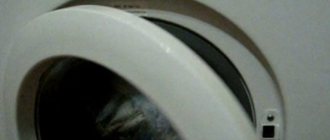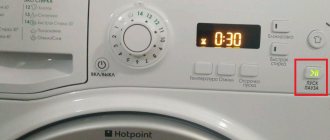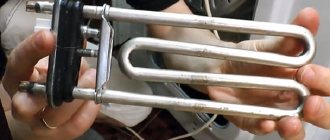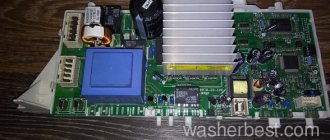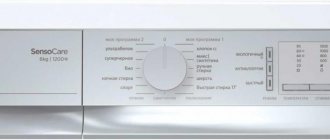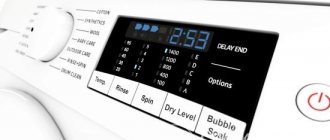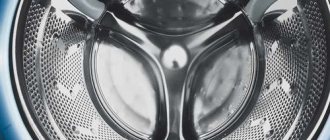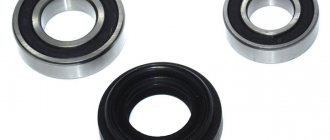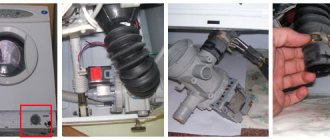The main reasons for washing machine contamination
There are 2 types of blockages:
- mechanical;
- natural.
Experts believe that the main cause of mechanical blockages in a washing machine is the ingress of foreign small objects into the filtration system of the washing machine. Small objects entering the liquid drain system completely block it.
Various small objects and contaminants can get not only into the laundry container of the washing machine, but also into other areas of this household appliance.
Poorly treated tap water can be the main reason for rapid contamination of the machine, along with dirty laundry. Along with dirty clothes, substances such as:
- Solid dirt particles;
- Threads;
- Various small items (coins, pins, etc.).
When washing, grease deposits often settle on the walls of the drum, which can cause the spread of bacteria and mold fungi.
To prevent foreign small particles and dirt from getting into the washing machine, it is enough to adhere to the following rules:
- Immediately before starting the washing process, you must carefully check the pockets and clean them of small debris;
- Items made from thin or damaged fabrics are recommended to be washed in special bags;
- Before the washing process, you need to shake off dust and dirt from clothes and other things.
But even if you follow all the basic rules, it is still difficult to prevent the formation of limescale that settles inside the drum, on the heating element and other components of the washing machine.
Scale can be the main cause of device failure. Plaque occurs due to water that contains metal salts. To soften the water used, it is necessary to use products such as Calgon or Alfagon.
But at the same time, there are expert opinions that frequent use of these products can cause damage to parts of the washing machine.
To provide the device with clean water, it is also recommended to install special purification filters at the water supply inlet.
A list of possible malfunctions, moving from the simplest and most accessible testing options to complex ones until you come across a breakdown.
First, let's open the drain of the garbage filter, first unscrewing the filter itself. A blockage often forms right in the drain; if this is the case, then you can stop searching.
If there is no debris in the drain, disconnect the washing machine from the network and water supply with sewerage and move it to the middle of the room. We tilt the machine on its left side and through the bottom of the washer we get to the pump, as well as the pipe that is adjacent to it. At this stage, we check the pump, the adjacent pipe and the drain hose.
If a blockage or other malfunction is still not detected, unscrew the pump through the bottom of the washing machine, and then the washing machine motor. Now nothing prevents us from checking the main pipe going from the tank to the garbage filter. This is not particularly convenient, but it is still better than removing the front wall of the washing machine.
If in this case a malfunction or blockage is not detected, feel free to contact a specialist. Most likely, the matter is serious and the problem cannot be solved on your own.
What tool will we use?
Before you turn on self-cleaning, you should stock up on a suitable cleaning product. Regular powder will not work - you need a special composition, which is purchased separately. It is better not to experiment with brands, but to choose already proven cleaners.
- A liquid product produced in Japan and capable of dealing with soap scum, fungus, scale and other dirt. Sold in 550 ml bottles, which is enough for one-time cleaning of a machine with a capacity of up to 9 kg. The cost varies between 6-6.3 dollars.
- Japanese tablets with proven effectiveness. They remove any dirt and are attractive at a relatively low price. A pack of 5 tablets costs about $2.
- Dutch anti-mold powder for all types of washing machines. Sold in packs of 0.162 liters for $10.
Before use, you must read the instructions on the package and strictly follow the given dosages. Otherwise, the desired effect will not be achieved, and the expensive product will be wasted.
What should you not clean your machine?
In an effort to save money, some housewives begin to “cheat” and look for an alternative to expensive powder among the means at hand. Tips and recommendations are available on the Internet, however, not all of the listed “analogs” can be considered effective and safe.
So, most often on forums it is advised to use white, various acids and Coca-Cola drink as a detergent when turning on the self-cleaning mode. Unfortunately, none of the listed liquids will save money; on the contrary, they will damage the machine and incur additional costs.
- White. It is rightfully considered a powerful and effective cleaner and, thanks to the concentrated chlorine in its composition, it will quickly wash away dirt and scale from the “insides” of the machine. However, there is a significant “but” - the substance strongly corrodes rubber parts, which will lead to breakdowns and leaks.
- Acids. Like whiteness, they will cause significant damage to the rubber cuffs and gaskets of the machine. Plus, metal components will also suffer: the drum will darken, the shaft and heating element will oxidize. Some users burned through the drain hose with liquid.
- Cola. It is famous for its cleaning qualities, but the available concentration of active substances is not enough to completely clean the machine. It will take about 15-20 liters, which is several times more expensive than special equipment.
READ MORE: Petunia in flowerpots 40 photos of the best varieties of petunias for hanging flowerpots How to plant them correctly How to feed petunia for abundant flowering
There is no point in saving money on cleaning the machine. Aggressive and untested chemistry will do more harm than good. There is a high probability that budget experiments will lead to the need to purchase a new washing machine.
Frequent breakdowns
The most common malfunction of Hotpoint-Ariston washing machines is the failure of the heating element (it does not heat the water. The main reason for this lies in the use of hard water when washing. The drain pump or pump in such machines often breaks down, after which it is impossible to drain the water. Failure of such This kind of problem is provoked by long-term use of the equipment.Over time, the gasket in the fill valve can also fail - it becomes hard and begins to let water through (the machine leaks from below).
Doesn't turn on
Most often, the machine does not work when turned on due to a damaged control module or a malfunction of the power cord or socket. It’s easy to check that the outlet is working properly – you just need to plug in another device. As for the damage to the cord, it can be easily noticed visually. Only specialists can repair the module, since they reflash it or replace it with a new one. Also, the machine may not turn on if:
- a faulty valve or a clogged hose; due to lack of water, the equipment cannot start working;
- The electric motor has failed (the breakdown is accompanied by extraneous noise), as a result of which the machine draws water, but the washing process does not begin.
- Doesn't drain water
This problem most often occurs due to a clogged drain system, a breakdown of the control unit or pump.
Doesn't wring out
This breakdown, as a rule, occurs for three main reasons: the motor has failed (this is accompanied by a lack of rotation of the drum), the tachometer that regulates the speed of rotation of the rotor is broken, or the belt has broken. The performance of the engine and the integrity of the belt are determined by removing the back cover of the machine, having first unscrewed the screws. If the cause of the breakdown lies not in the engine, but in a malfunction of the tachometer, then it is advisable to call a specialist.
The belt comes off
This problem usually occurs after long-term use of the equipment. Sometimes it is observed in new machines, if they are of poor quality or the load of laundry is exceeded, as a result of which the drum rotates, leading to the belt being thrown off. In addition, the belt can fly off due to poor fastening of the drum pulley and motor. To solve this problem, you need to remove the back cover of the machine and tighten all the fasteners, after which the belt is installed in its place.
Doesn't spin the drum
This is considered one of the most serious breakdowns, the elimination of which cannot be delayed. If the machine starts and then stops (the drum stops rotating), then this may be a consequence of uneven distribution of the laundry, which causes an imbalance or breakdown of the drive belt or heating element. Sometimes the appliance spins during washing, but not during the spin cycle. In this case, you need to check whether the program was selected correctly. There may also be a problem with the control board.
The drum can stop rotating immediately after collecting water.
Doesn't take up water
The main reasons why the Hotpoint-Ariston machine cannot draw water may be a problem with the control module, a clogged inlet hose, a failure of the inlet valve, or a malfunction of the pressure switch. All of the above malfunctions can be easily diagnosed and corrected on your own, with the only exception being the breakdown of the module, which is difficult to replace at home.
The door won't close
Sometimes, after loading the wash, the machine door does not close. There may be several reasons for this problem: mechanical damage to the door, which no longer locks and makes a characteristic click, or an electronic malfunction, which is accompanied by the hatch not locking. Mechanical failure most often occurs due to simple wear and tear of the equipment, due to which the plastic guides are deformed. During long-term use of the equipment, the hinges holding the hatch door may also sag.
Doesn't heat water
In the case when washing is carried out in cold water, the heating element is most likely broken. Replace it quickly: first of all, you need to carefully remove the front panel of the device, then find the heating element and replace it with a new one. A common cause of heating element failure is mechanical wear or accumulated lime.
How to start the wash?
How to properly use the washing machine and turn it on for the first time is written in detail in the manufacturer’s instructions, which are necessarily included with the household appliance. To start the Hotpoint-Ariston washing machine, you need the following.
- Connect the device to the electrical network. All manufacturers and experts recommend installing a separate outlet and machine for the washing machine. This guarantees safe operation.
- Place laundry items in the drum.
- Pour the powder into the detergent tray.
- Close the door or lid well.
- Select one of the washing programs on the control panel.
- Decide and select the desired temperature mode.
- Turn on "Spin".
- Press the “Start” button.
Dishwasher Hotpoint Ariston detailed instructions and possible malfunctions
Hotpoint Ariston dishwasher - the operating instructions for the unit give basic recommendations for working with this device.
This housewife's assistant, like many other units, requires careful handling. Complex household appliances must be used correctly. Hotpoint Ariston dishwasher (photo source - Yandex.Images )
Source: https://zen.yandex.ru/media/id/5c1df2d024879800ab906050/posudomoika-hotpoint-ariston-podrobnaia-instrukciia-i-vozmojnye-neispravnosti-5e031de292414d00afacdb9a
How to set the desired mode?
The selection is made using the programmer knob. There are inscriptions and icons around the selector switch. On older models there are no verbal designations - only icons, hence the problems with choice. It happens that the owners of the machines do not understand the images, then they need instructions to decipher the symbols. In the new models, the manufacturer took this omission into account - all icons are duplicated with words.
Before you set the mode, you need to sort the things that you are going to wash. Evaluate them by type of fabric, color, degree of soiling. Taking these positions into account, a decision is made: choose a ready-made program or customize your own. If preference falls on the second option, then the user selects:
- temperature;
- duration of the process;
- rotational speed.
Whether a ready-made program is included or your own is being configured, the user can add additionally:
- soak;
- rinsing;
- light ironing;
- spin
The process can be delayed for a certain time, depending on the duration of the timer. Typically, the maximum delayed start time is 24 hours. Descriptions of the modes can be read in the instructions.
How to activate auto-clean mode
The washing machine drum needs an annual service. If the unit operates frequently, autocleaning is activated several times. After this, the quality of the process meets the standard, and the machine remains operational for a long time.
To clean a unit that has an auto-clean function, you must turn on this program and wait for it to complete. It must be remembered that you will not remove scale with this procedure.
To use the auto-clean function, you must complete the following steps:
- remove the items in it from the drum;
- close the loading door, activate the “power” button;
- If your washing equipment does not have a special auto-cleaning function, press the key with an asterisk on it and hold it for up to three seconds. The display will show “tei”, indicating that the drum cleaning process has begun;
- After this message appears, press the “start” button to activate the mode. At the same time, the pre-wash LED lights up;
- The washing device cleans the drum within one and a half hours.
As soon as auto-cleaning is completed, the unit is disconnected from the power supply and the door is opened for drying.
The SMA is cleaned inside, getting rid of lint, hair and small debris. The unit operates in water heating mode up to sixty degrees, performs one and a half thousand rotations per minute, so purchased or improvised cleaning products are not required.
From the point of view of the operation of the SMA, the auto-cleaning process looks like this:
- Pre-wash is performed first;
- the main process is carried out;
- The main and additional rinse with spin begins.
Companies involved in the production of washing machines do not recommend using chemical compounds and especially descaling agents and washing powders when auto-cleaning the system. The fact is that their use is associated with the formation of a large amount of foam, which can cause the machine to leak.
Many machine models are equipped with a special button that activates cleaning. It is forbidden to run such a program if there are things in the drum, because the machine will have to accelerate to the maximum number of revolutions, the drum with things will move unevenly and make sudden movements. The washing machine will malfunction.
Using the self-cleaning function
Over time, any equipment requires cleaning and maintenance. The self-cleaning mode of the washing machine is a special function that allows you to clean the unit from grease, dirt and other contaminants.
The “Self-Cleaning” mode, present in most modern washing machines, was developed by the manufacturer specifically to remove insoluble substances remaining in the drum and tank.
Important: the drum must be cleaned at least once a year. If washing is done more often, then cleaning is required more often. Then the quality of washing will correspond to the norm, and the machine will remain in working order for many years.
To clean the machine using the self-cleaning function, you just need to start this program and wait until it runs, but remember that it will not deal with scale, but will only remove mold and grease from the internal surfaces of the washer.
To use the self-cleaning function you must:
- Remove from the drum if they are there;
- Close the loading hatch and press the button on the “Power” panel;
- If the model does not have an explicit “Self-Cleaning” mode, then you should press the button with the “*” image and hold it for at least three seconds. The inscription “tei” should appear on the display - that is, the drum self-cleaning mode will turn on;
- If the message appears, turn on “Start” to start the mode. At the same time, the pre-wash LED should light up;
- The washer will clean the drum itself and its operation usually lasts about an hour and a half.
Upon completion of cleaning, you should turn off the machine from the network and open the loading hatch for ventilation and drying.
The self-cleaning program cleans the inside of the machine and rids it of lint, hair and foreign objects. Since the mode provides for the operation of the unit at a temperature of 60 degrees, at a speed of up to one hundred and fifty revolutions per minute, its owner practically does not have to use commercial or folk cleaning products.
Self-cleaning from the point of view of the unit looks like this:
- Prewash;
- Main wash (temperature already 60 degrees and rotation speed 150 rpm;
- Double rinse and spin.
Experts recommend performing such prevention at least once a month. Important: manufacturers of most washing machines do not recommend using chemicals when cleaning the unit, in particular means for removing limescale and washing powders. An excessive amount of foam generated when using them can lead to leakage of the washing machine.
Many machines have a special button, pressing which immediately activates the self-cleaning process. The prohibition on using the self-cleaning program together with things in the drum is due to the fact that when this program is executed, the machine accelerates to high speeds, the drum makes uneven and sudden movements. If there is laundry in it, both it and the machine itself may suffer.
How to activate auto-clean mode
The washing machine drum needs an annual service. If the unit operates frequently, autocleaning is activated several times. After this, the quality of the process meets the standard, and the machine remains operational for a long time.
To clean a unit that has an auto-clean function, you must turn on this program and wait for it to complete. It must be remembered that you will not remove scale with this procedure.
To use the auto-clean function, you must complete the following steps:
- remove the items in it from the drum;
- close the loading door, activate the “power” button;
- If your washing equipment does not have a special auto-cleaning function, press the key with an asterisk on it and hold it for up to three seconds. The display will show “tei”, indicating that the drum cleaning process has begun;
- After this message appears, press the “start” button to activate the mode. At the same time, the pre-wash LED lights up;
- The washing device cleans the drum within one and a half hours.
As soon as auto-cleaning is completed, the unit is disconnected from the power supply and the door is opened for drying.
The SMA is cleaned inside, getting rid of lint, hair and small debris. The unit operates in water heating mode up to sixty degrees, performs one and a half thousand rotations per minute, so purchased or improvised cleaning products are not required.
From the point of view of the operation of the SMA, the auto-cleaning process looks like this:
- Pre-wash is performed first;
- the main process is carried out;
- The main and additional rinse with spin begins.
Companies involved in the production of washing machines do not recommend using chemical compounds and especially descaling agents and washing powders when auto-cleaning the system. The fact is that their use is associated with the formation of a large amount of foam, which can cause the machine to leak.
Many machine models are equipped with a special button that activates cleaning. It is forbidden to run such a program if there are things in the drum, because the machine will have to accelerate to the maximum number of revolutions, the drum with things will move unevenly and make sudden movements. The washing machine will malfunction.
